Overview
A core circuit workout is a structured fitness routine designed to strengthen and stabilize the torso by targeting key muscle groups in the abdomen, lower back, hips, and pelvis through a series of exercises. The article highlights that these workouts not only enhance athletic performance and posture but also reduce injury risk, supported by research indicating improved muscle activation and endurance in participants engaged in such training.
Introduction
In a world where physical fitness is increasingly recognized as a cornerstone of overall well-being, the significance of core circuit workouts cannot be overstated. These dynamic routines are designed to strengthen the torso, engaging essential muscle groups that support not only athletic performance but also daily activities.
As organizations strive to cultivate healthier work environments, integrating core workouts into fitness programs emerges as a strategic move that benefits both individuals and teams. With a focus on enhancing strength, stability, and endurance, these exercises not only improve posture and reduce injury risk but also contribute to a culture of resilience and vitality.
By embracing the power of core circuit workouts, teams can unlock their full potential, paving the way for greater productivity and well-being in the workplace.
Defining Core Circuit Workouts: An Overview
A core circuit workout is integral to developing a robust and resilient torso, targeting key muscle groups such as the abdomen, lower back, hips, and pelvis. Crafted in a circuit layout, these routines comprise a sequence of exercises that involve various central regions, improving strength, stability, and endurance. This comprehensive approach is vital not only for overall fitness but also for optimizing functional movement.
Recent research, approved by the Bioethics Committee of the University of Bologna, underscores the benefits of these workouts, showcasing small but significant effects on throwing and hitting velocity performance (ES = 0.30; p = 0.14), with statistical analysis setting significance at p < 0.05. Furthermore, rigorous evaluations of fundamental training studies have revealed a moderate level of evidence, indicating a need for high-quality research to refine our understanding of muscle activity. As indicated by author J.M.M.:
The level of evidence of the included studies was primarily moderate, which suggests that more high-quality research is necessary to reduce the risk of bias and draw solid conclusions about central muscle activity.
The risk of bias assessment, conducted using the Cochrane Rob tool, categorized the evidence quality into low, unclear, or high across seven domains, ensuring a rigorous evaluation of the studies' methodologies. By integrating a core circuit workout into fitness regimens, individuals can experience enhancements in athletic performance, improved posture, and a reduced risk of injury—benefits that are valuable in both personal and professional settings.
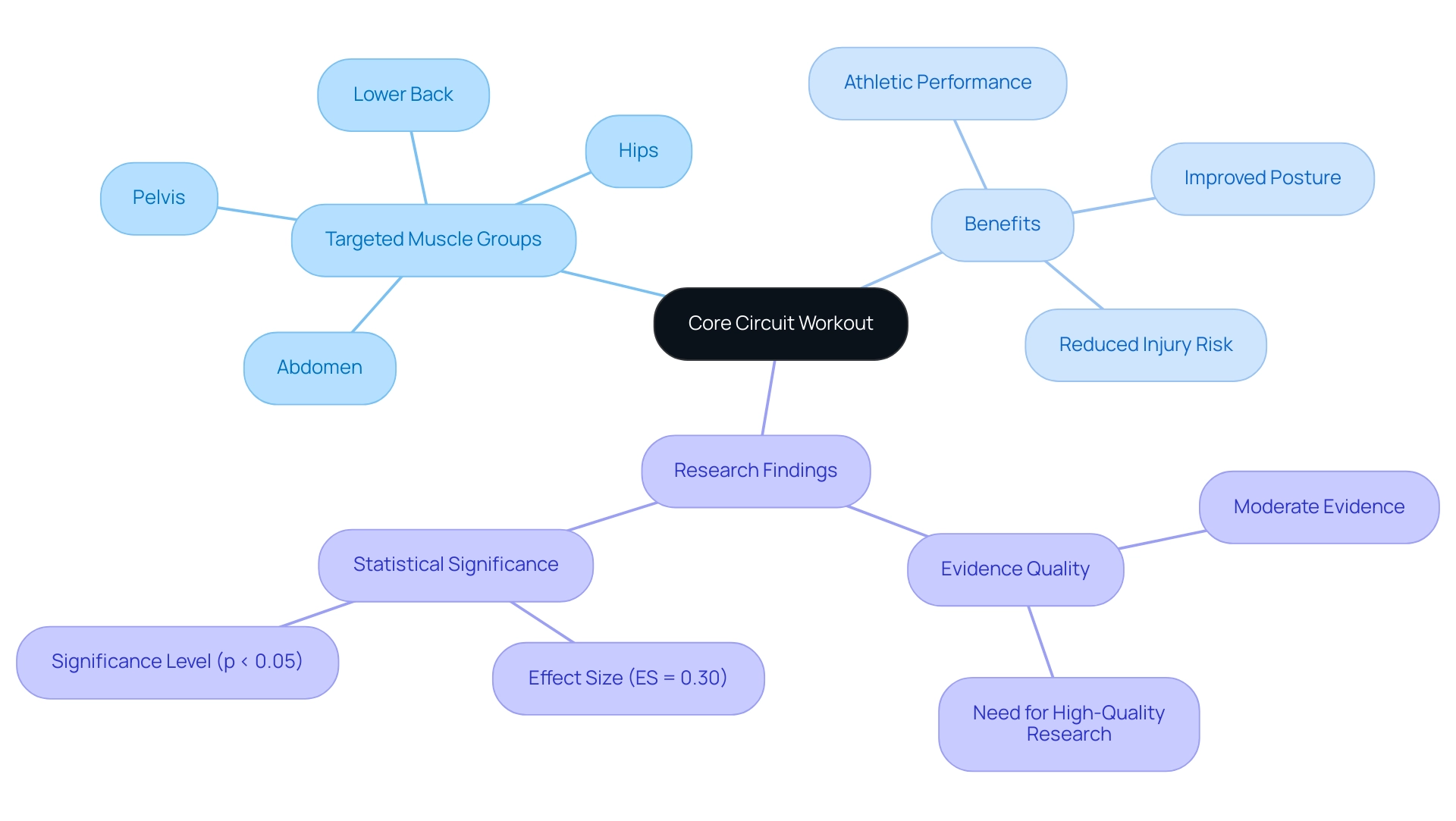
The Benefits of Core Circuit Workouts for Fitness Enthusiasts
Core circuit workouts are a powerful tool for fitness enthusiasts, providing numerous benefits that go well beyond mere aesthetics. Participating in these exercises results in significant enhancements in abdominal strength, stability, and posture—essential elements for optimal physical performance. As Wendi Weimar, PhD and director of the Sport Biomechanics Laboratory at Auburn University, aptly states,
When you swing a tennis racket, kick a soccer ball, or pick up a crying toddler, your central muscles should activate before your limbs get to work.
This highlights the central component's essential role in everyday activities and athletic endeavors alike. Recent findings indicate that central activation increased from 0.0197 ± 0.0202 to 0.0327 ± 0.0370 μV in participants engaged in central training, showcasing the workout's effectiveness. Moreover, a study linked to the University of Tennessee Health Science Center College of Graduate Health Sciences involving 25 male college athletes revealed that an 8-week training program significantly improved abdominal endurance and running efficiency.
The study utilized various tests, including:
- Sensory organization
- Endurance plank
- Treadmill running assessments
to rigorously evaluate performance, demonstrating the profound impact of fundamental strength on athletic performance. Importantly, the authors declared that no competing interests exist, reinforcing the integrity of this research. By strengthening the muscles that support the spine and pelvis, exercises play a crucial role in injury prevention, enabling individuals to pursue their fitness objectives with assurance and energy.
Additionally, these exercises can elevate metabolism, contributing to effective weight management and overall fitness. Adopting a core circuit workout is not merely a suggestion; it’s a tactical choice towards achieving optimal performance and wellness for you and your group.
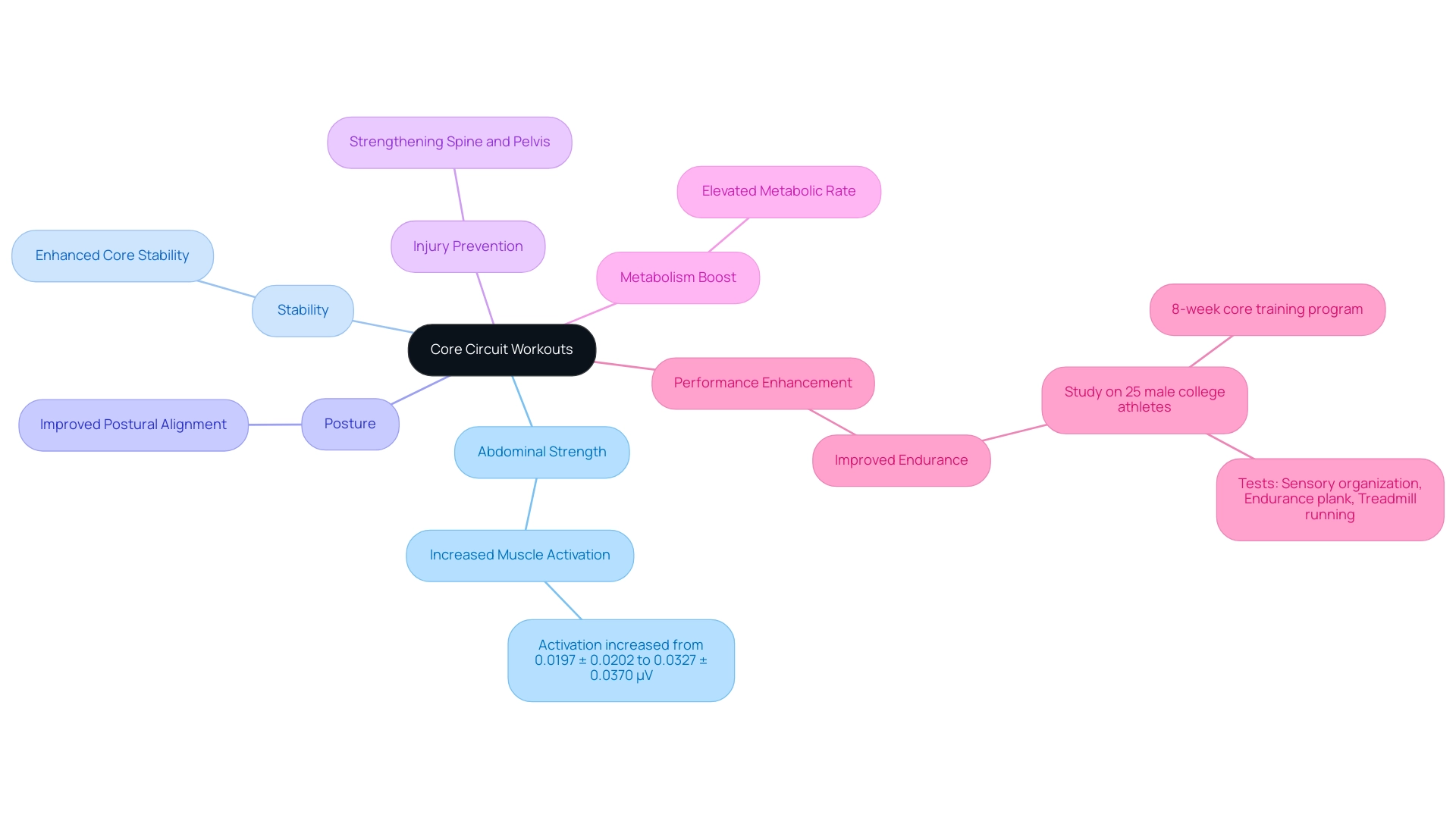
Key Exercises in Core Circuit Workouts: Techniques and Tips
A core circuit workout is essential for enhancing team performance, with several key exercises standing out for their effectiveness. Planks, Russian twists, bicycle crunches, and mountain climbers are foundational movements that can be easily integrated into any fitness regimen. To master the plank, ensure your body forms a straight line from head to heels while balancing on your forearms and toes; remember to activate your midsection for maximum stability.
- Russian twists are performed by sitting on the floor with your knees bent, leaning back slightly, and twisting your torso side to side while holding a weight, which effectively targets the obliques.
- Bicycle crunches not only activate the rectus abdominis but also challenge the obliques, making them a comprehensive abdominal workout.
- Mountain climbers provide an energetic method to increase heart rates while reinforcing the midsection.
A study indicated that back extension activities showed greater activation in stability routines, achieving approximately 63% MVIC, highlighting the effectiveness of these movements. Significantly, each of these activities can be adjusted to suit different fitness levels, ensuring that everyone on your team can take part in the core circuit workout and benefit from the routine. As Eleftherios Kellis noted, 'A Comparison between Fundamental Stability Activities and Muscle Thickness Using Two Different Activation Maneuvers' highlights the significance of targeted routines in developing abdominal strength.
Moreover, the application of ultrasound measurement methods in research has yielded dependable assessments of muscle thickness during various activities, enabling a comparative analysis of muscle activation. Adopting these fundamental exercises not only enhances personal well-being but also cultivates a culture of health and resilience within your team.
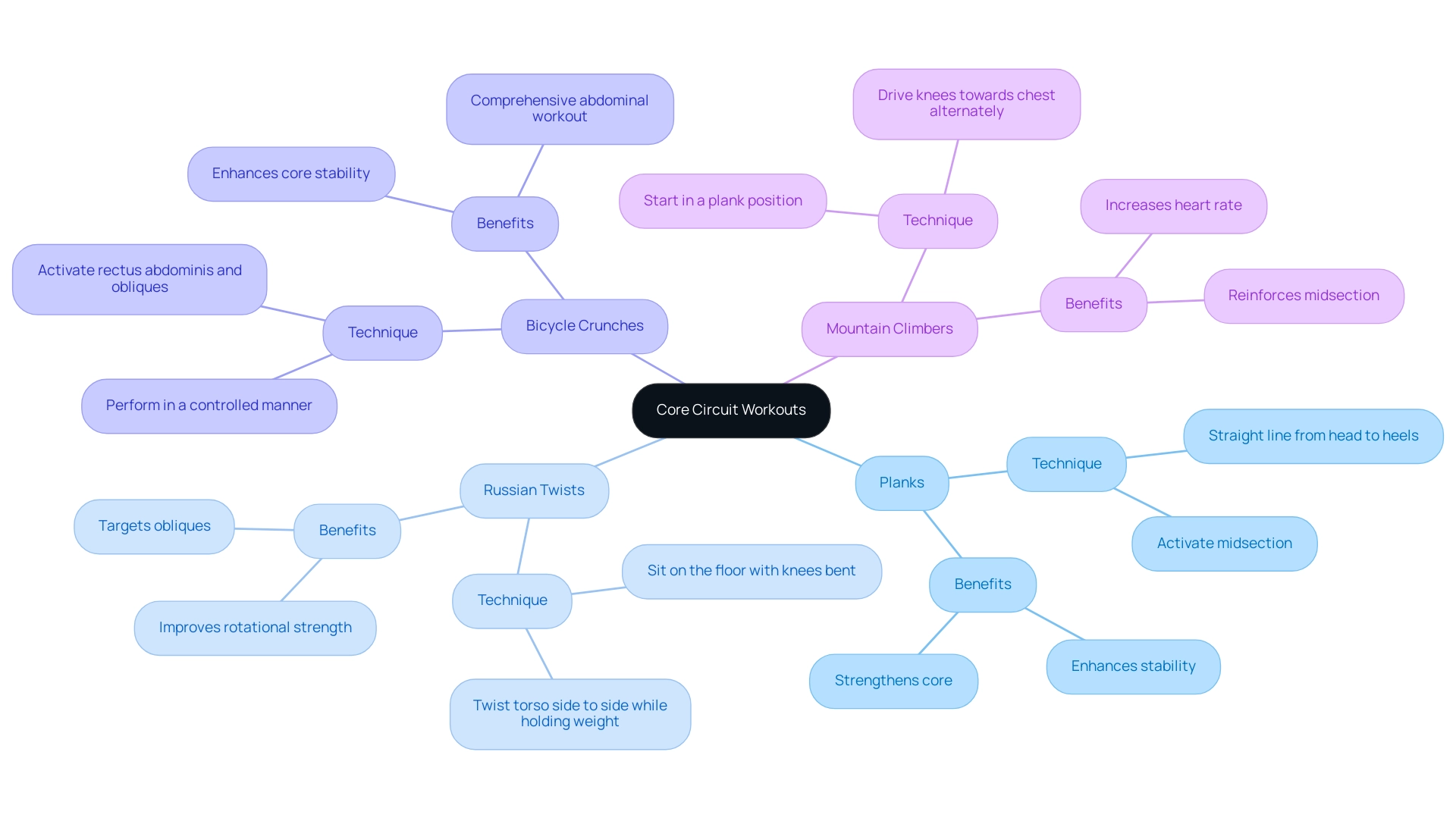
Mastering Form: Ensuring Safety and Effectiveness in Core Workouts
Mastering proper form in abdominal exercises is not merely a suggestion—it's essential for avoiding harm and improving overall effectiveness. Key strategies include:
- Maintaining a straight back during planks to avoid unnecessary strain
- Actively engaging your core muscles throughout every movement
For exercises such as bicycle crunches, making sure that your lower back stays in contact with the floor is vital for avoiding arching, which can result in discomfort and harm.
Start with fewer repetitions, gradually increasing the intensity as your strength builds. To enhance your practice, consider using mirrors or recording your workouts; this allows you to monitor your form and make adjustments in real time.
Recent findings indicate that a significant number of physically active individuals encounter sports-related issues, often due to a lack of awareness regarding proper techniques. An online survey conducted to evaluate the epidemiology of musculoskeletal sports-related conditions among physically active individuals in the UK revealed that many participants had sustained harm, highlighting the prevalence of this issue. Furthermore, approximately 65,000 children ages 14 and under were treated for trampoline-related harm, highlighting the broader implications of risk associated with physical activities.
As noted by Philip G. Conaghan from the Leeds Institute of Rheumatic and Musculoskeletal Medicine, "The lack of awareness or concern regarding the long-term complications of sports-related damage was evident in this study." This underlines the importance of mastering form not only for immediate safety but also for long-term health. By prioritizing proper activity techniques, you can help your team minimize injury risks and foster a culture of wellness and safety in physical pursuits.
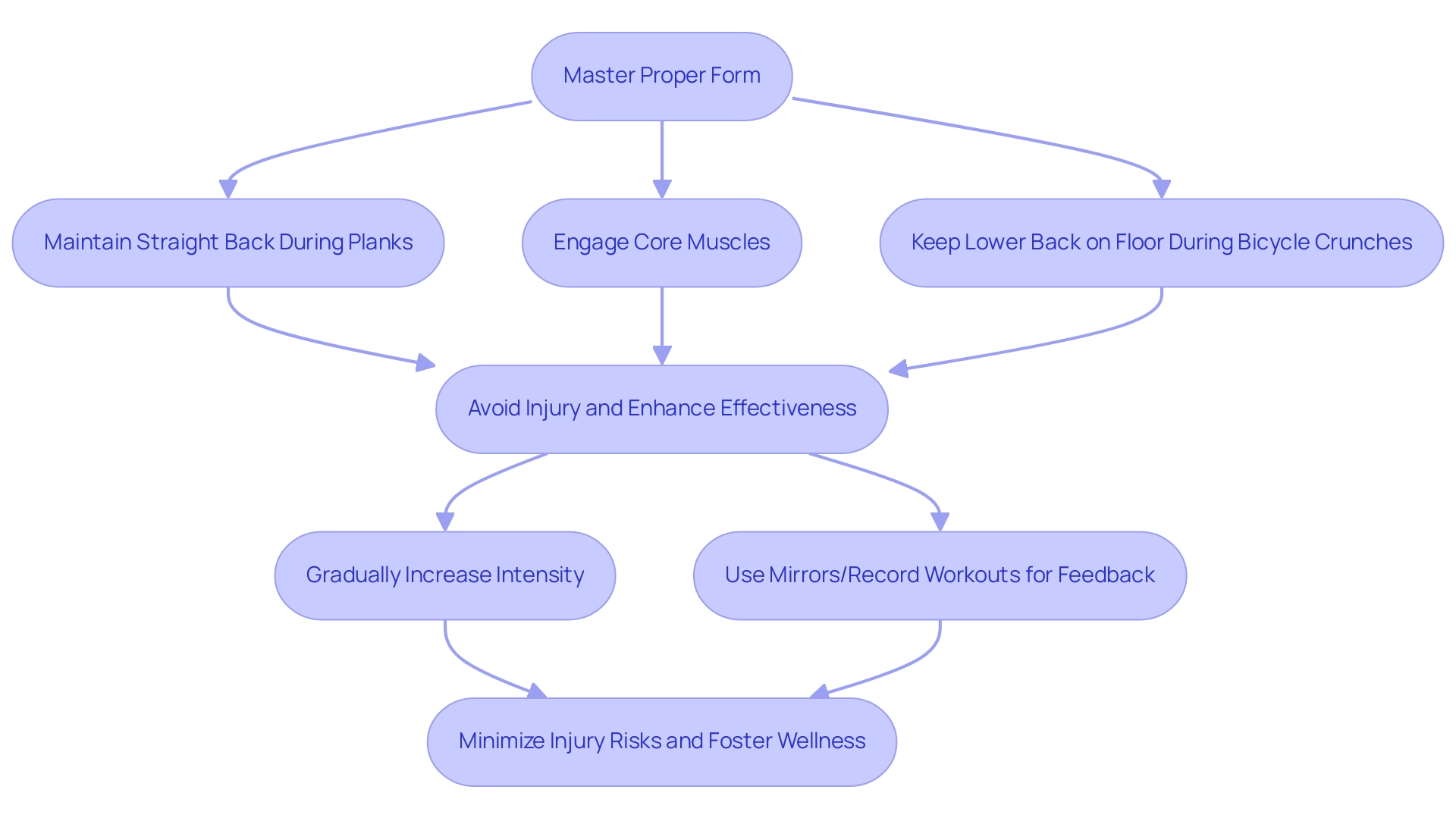
Structuring Your Core Circuit Workout: A Guide to Effective Routines
To create an effective core circuit workout that improves team performance, concentrate on choosing 4-6 activities that target different areas of the core, establishing a balanced method to strength training. Incorporate movements like:
- Toe Touches
- Planks
- Russian twists
- Bicycle crunches
into a core circuit workout format. Aim for 30-60 seconds of intense work followed by a brief rest of 15-30 seconds between activities.
To maximize effectiveness, repeat this core circuit workout 2-4 times. Warm-up before starting and cool down afterward to prevent injury and enhance recovery. Importantly, changing activities regularly not only invigorates the routine but also helps maintain progress by preventing plateaus.
Aim to schedule essential workouts 2-3 times per week for optimal results. As fitness expert Sam Spinelli emphasizes, understanding how proper bracing and maintaining intra-abdominal pressure are crucial for performance, especially in heavy lifts. Notably, the initial 23% of maximum lumbar flexion ROM has been identified as the neutral zone, underscoring the importance of maintaining proper form during exercises.
For instance, the forearm plank position with forward reaches exemplifies how maintaining stability while challenging balance can lead to significant improvements in abdominal strength. By integrating these core circuit workouts into your corporate wellness programs, which include personalized attention from dedicated health coaches and a customized app for tracking progress, you can inspire your team to prioritize their well-being and performance. This holistic approach not only enhances individual health but also fosters collective productivity and engagement, ultimately contributing to reduced absenteeism and lower healthcare costs.
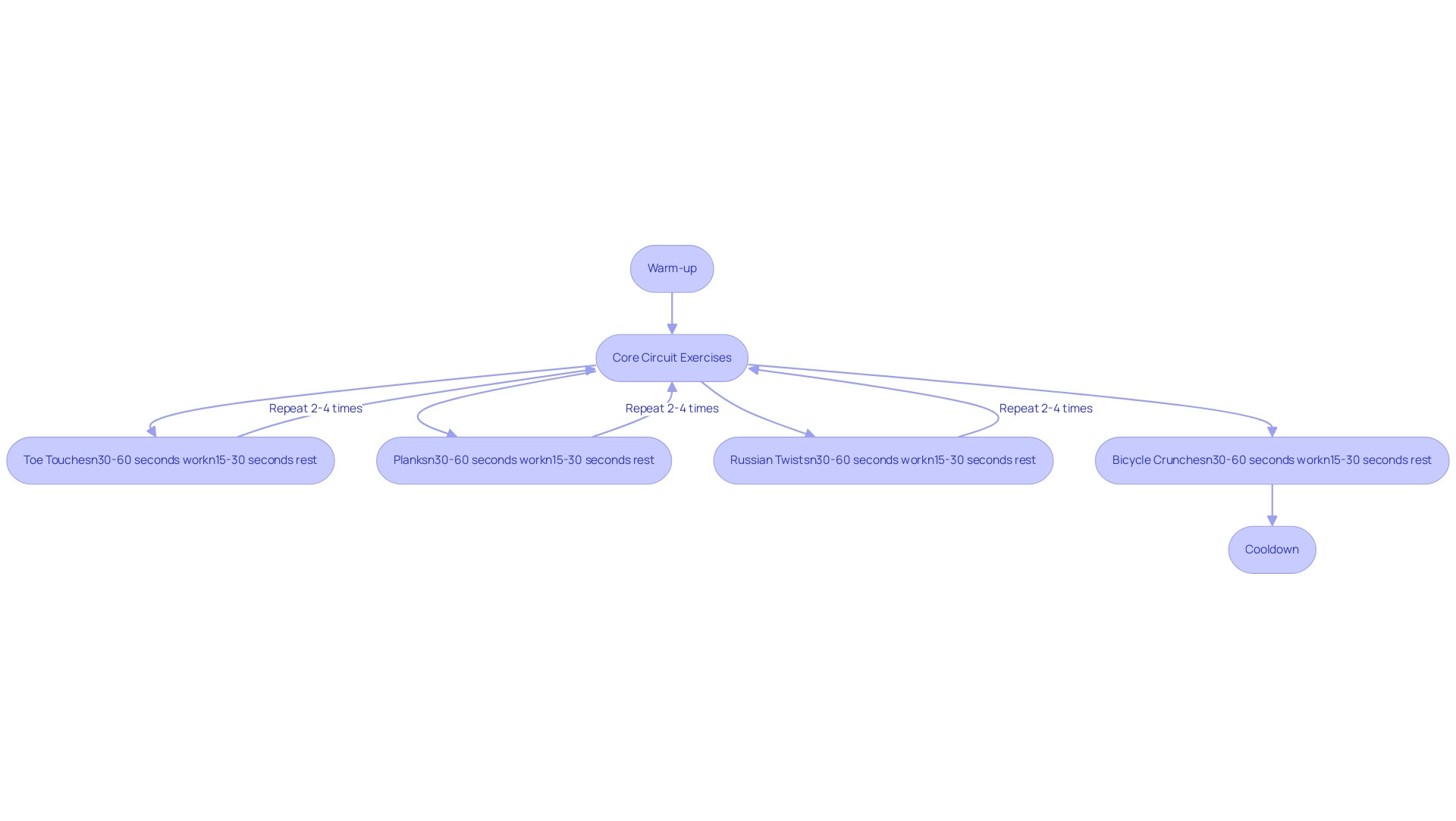
Conclusion
Core circuit workouts represent a transformative approach to enhancing physical fitness and overall well-being. These dynamic routines engage essential muscle groups, improving strength, stability, and endurance, which are vital for both athletic performance and daily activities. By integrating core workouts into fitness programs, organizations can cultivate healthier work environments that promote resilience and vitality among teams.
The benefits of core circuit workouts extend beyond aesthetics; they play a crucial role in injury prevention and athletic performance enhancement. Key exercises such as:
- Planks
- Russian twists
- Mountain climbers
not only strengthen the core but also elevate metabolism, contributing to effective weight management. Moreover, mastering proper form is essential for maximizing these benefits and minimizing injury risks, ensuring participants can confidently engage in their fitness journeys.
As teams embrace core circuit workouts, they unlock their full potential, paving the way for increased productivity and well-being in the workplace. Prioritizing these routines is not merely a fitness choice; it is a strategic investment in the health and performance of individuals and teams alike. Encouraging a culture that values fitness and wellness will ultimately lead to a more engaged, resilient, and productive workforce. Now is the time to take action and integrate core circuit workouts into your wellness initiatives for a healthier, more dynamic team.
Frequently Asked Questions
What is a core circuit workout?
A core circuit workout is a fitness routine designed to develop a robust and resilient torso by targeting key muscle groups such as the abdomen, lower back, hips, and pelvis. It consists of a sequence of exercises that improve strength, stability, and endurance, optimizing functional movement.
What are the benefits of core circuit workouts?
Core circuit workouts enhance athletic performance, improve posture, reduce the risk of injury, and elevate metabolism, contributing to effective weight management and overall fitness.
What does recent research say about the effectiveness of core circuit workouts?
Recent research indicates that core circuit workouts lead to small but significant improvements in throwing and hitting velocity performance. However, the studies reviewed show a moderate level of evidence, suggesting a need for more high-quality research to better understand muscle activity.
How was the quality of evidence assessed in the studies related to core circuit workouts?
The risk of bias in the studies was assessed using the Cochrane Rob tool, categorizing evidence quality into low, unclear, or high across seven domains to ensure a rigorous evaluation of the methodologies.
What specific improvements have been observed in athletes participating in core circuit training?
Athletes participating in core circuit training have shown significant improvements in abdominal endurance and running efficiency, as demonstrated by an 8-week training program involving various performance tests.
Why is central muscle activation important?
Central muscle activation is essential for optimal physical performance, as it engages the core muscles before the limbs, which is crucial during various activities such as sports and daily tasks.
How do core circuit workouts contribute to injury prevention?
By strengthening the muscles that support the spine and pelvis, core circuit workouts play a crucial role in preventing injuries, allowing individuals to pursue their fitness goals with confidence.

